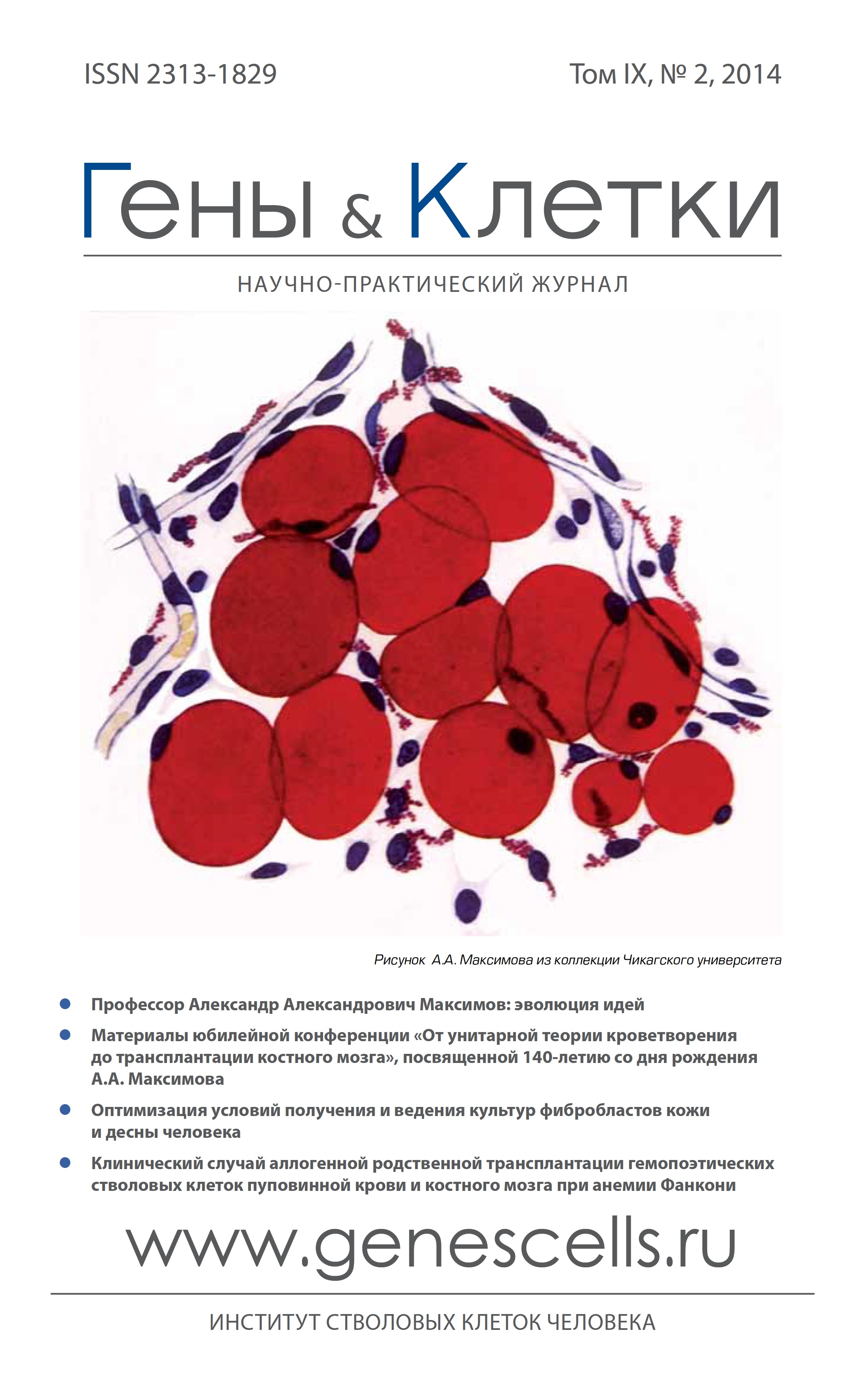Hyaluronan-based bioplastic material as a scaffold for biomedical cell-based express-product for skin regeneration
- Authors: Kalmykova N.V1, Spichkina O.G1, Ellinidi V.N1, Rakhmatullin R.R2, Moiseev S.I1
-
Affiliations:
- A.M. Nikiforov Russian Center of Emergency and Radiation Medicine, Saint-Petersburg, Russia
- Orenburg State University, Orenburg, Russia
- Issue: Vol 9, No 2 (2014)
- Pages: 68-75
- Section: Articles
- URL: https://genescells.ru/2313-1829/article/view/120262
- DOI: https://doi.org/10.23868/gc120262
- ID: 120262
Cite item
Abstract
This study is designed to investigate the behavior of human fibroblasts and keratinocytes on hyaluronan-based bioplastic material «G-DERM». Cell viability, proliferation, interleikin-6 and keratinocytes growth factor secretion were investigated. The results suggested that «G-DERM» was not toxic and supported cell adhesion and spreading. Histological analysis showed that «G-DERM» properties and porous structure provided distribution of skin cells by cell-type manner. Fibroblasts on «G-DERM», being quiescent, kept their synthetic activity and produced tissue-specific factors of wound healing. According to study results «G-DERM» can be used as 3D cell matrix for regenerative medicine.
Keywords
About the authors
N. V Kalmykova
A.M. Nikiforov Russian Center of Emergency and Radiation Medicine, Saint-Petersburg, Russia
O. G Spichkina
A.M. Nikiforov Russian Center of Emergency and Radiation Medicine, Saint-Petersburg, Russia
V. N Ellinidi
A.M. Nikiforov Russian Center of Emergency and Radiation Medicine, Saint-Petersburg, Russia
R. R Rakhmatullin
Orenburg State University, Orenburg, Russia
S. I Moiseev
A.M. Nikiforov Russian Center of Emergency and Radiation Medicine, Saint-Petersburg, Russia
References
- MacNeil S. Progress and opportunities for tissue-engineered skin. Nature 2007; 44: 874-80.
- Shevchenko R.V., James S.L., James S.E. A review of tissue-engineered skin bioconstructs available for skin reconstruction. J.R. Soc. Interface 2010; 7 (43): 229-58.
- Бурлуцкая О.И., Рахматуллин Р.Р, Бурцева Т.И., Адель-шин А.И. Гистоэквивалент-биопластический материал. Патент RU2513838. 20.04.2014.
- Рахматуллин Р.Р. Биопластический материал на основе ги-алуроновой кислоты: биофизические аспекты фармакологических свойств. Фармация 2011; 4: 37-9.
- Зиновьев Е.В., Рахматуллин Р.Р., Османов К.Ф. и др. Био-пластические дерматотерапевтические системы на основе гидроколлоида гиалуроновой кислоты и пептидного комплекса. Вест-ровании клеток кожи на материале «G-DERM» выявлена секреция фибробластами двух цитокинов - ФРК и ИЛ-6.
- Boyce S.T., Kagan R.J., Yakuboff K.P. et al. Cultured skin substitutes reduce donor skin harvesting for closure of excised, fullthickness burns. Ann. Surg. 2002; 235: 269-79.
- Спичкина О.Г., Калмыкова Н.В., Моисеев С.И. Клеточные технологии в лечении трофических язв и длительно незаживающих ран. Медико-биологические и социально-психологические проблемы безопасности в чрезвычайных ситуациях 2012; 4: 61-9.
- Wong V., Gurtner G. ^ssue engineering for the management of chronic wounds: current concepts and future perspectives. Exp. Dermatol. 2012; 21: 729-34.
- Regnier M., Patwardhan A., Scheynius A. et al. Reconstructed human epidermis composed of keratinocytes, melanocytes and Langerhans cells. Med. Biol. Eng. Comput. 1998; 36: 821-4.
- Ponec M., Ghalbzouri E., A., Dijkman R. et al. Endothelial network formed with human dermal microvascular endothelial cells in autologous multicellular skin substitutes. Angiogenesis 2004; 7: 295-305.
- Tonello C., Vindigni V., Zavan B. et al. In vitro reconstruction of an endothelialized skin substitute provided with a microcapillary network using biopolymer scaffolds. FASEB J. 2005; 19: 1546-8.
- Dezutter-Dambuyant C., Black A., Bechetoille N. et al. Evolutive skin reconstructions: from the dermal collagen-glycosaminoglycan-chitosane substrate to an immunocompetent reconstructed skin. Biomed. Mater. Eng. 2006; 16: S85-S94.
- Mulekar S.V. Long-term follow-up study of 142 patients with vitiligo vulgaris treated by autologous, non-cultured melanocyte-keratinocyte cell transplantation. Int. J. Dermatol. 2005; 44: 841-5.
- James S.E., Booth S., Dheansa B., et al. Sprayed cultured autologous keratinocytes used alone or in combination with meshed autografts to accelerate wound closure in difficult to-heal burns patients. Burns 2010; 36: 10-20.
- Currie L. J., Martin R., Sharpe J. R. et al. A comparison of keratinocyte cell sprays with and without fibrin glue. Burns 2003; 29: 677-85.
- Hernon C.A., Dawson R.A., Freedlander E. et al. Clinical experience using cultured epithelial autografts leads to an alternative methodology for transferring skin cells from the laboratory to the patient. Regen. Med. 2006; 1: 809-21.
- Sun T., McMinn P., Holcombe M. et al. Agent based modeling helps in understanding the rules by wich fibroblasts support keratinocytes colony formation. PLoS ONE 2008; 3(5): e2129.
- Jubin K., Martin Y., Lawrence-Watt D.J. et al. A fully autologous co-culture system utilizing non-irradiated autologous fibroblasts to support the expansion of human keratinocytes for clinical use. Cytotechnology 2011; 63: 655-62.
- Зиновьев Е.В., Кисленко А.М, Сивожелезов К.Г. и др. Возможности биопластики трофических язв гистоэквивалент-био-пластическим материалом на основе гидроколлоида гиалуроновой кислоты. Хирург 2014; 4: 14-21.
- Рева Г.И., Усов В.В., Митряшов К.В. Применение материала «G-DERM» для лечения «пограничных» ожогов. Сборник научных трудов IV съезда комбустиологов России 2013; 114-5.
- Vindigni V., Cortivo R., lacobellis L. et al. Hyaluronan benzyl ester as a scaffold for tissue engineering. Int. J. Mol. Sci. 2009; 10: 2972-85
- Solis M.A., Chen Y-H., Wong T.Y. et al. Hyaluronan regulates cell behavior: a potential niche matrix for stem cells. Biochem. Res. Int. 2012; 2012: 346972.
- Grinnel F. Fibroblast mechanics in three dimensional collagen matrices. J. Bodyw. Mov. Ter. 2008; 12 (3): 191-3.
- Brem H., Young J., Tomic-Canic M. et al. Clinical efficacy and mechanism of bilayered living human skin equivalent tHSE) in treatment of diabetic foot ulcers. Surg. Technol. Int. 2003; 11: 23-31.
- Kubo K., Kuroyanagi Y. A study of cytokines released from fibroblasts in cultured dermal substitute. Artif. Organs. 2005; 29 (10): 845-9.
- Werner S., Krieg T., Smola H. Keratinocyte-fibroblast interactions in wound healing. J. Investig. Dermatol. 2007; 127: 998-1008.
- Tang A., Gilchrest B.A. Regulation of keratinocyte growth factor gene expression in human skin fibroblasts. J. Dermatol. Sci. 1996; 11 (1): 41-50.
- Grossman, R. M., Krueger J., Yourish D. et al. Interleukin-6 is expressed in high levels in psoriatic skin and stimulates proliferation of cultured human keratinocytes. PNAS USA 1989; 86: 6367.
Supplementary files










